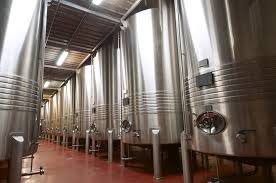Fermentation-Advantages & Application
Fermentation-Advantages&Application
Fermentation:
Fermentation,We know that in cellular respiration, glucose molecule goes through oxidation-reduction reactions to release energy in the form of ATP.Fermentation is the process in which there is incomplete oxidation-reduction of glucose.Fermentation has been in the knowledge of man since centuries,but it was believed that it is purely a chemical process .In 1857, pasteur convinced the scientific community that all fermentation are the results of microbial activity. He showed that fermentation is always accompanied y the development of microorganisms. There are many kinds of fermentation and each kind is a characteristic of particular microbial group.
Fermentations are classified in terms of the products formed.The initial steps of carbohydrate fermentation, are identical to those of respiration. The process begins with glycolysis, in which the glucose, molecule is broken in to two molecules of pyruvic acid. Different microorganisms proceed the further reactions in different ways. It results in the formation of various products from pyruvic acid.
The two basic typrs of carbohydrate fermentation are described next.
1.Alcoholic fermentation ( by yeast ) :
This fermentation is carried out by many types of yeast such as Saccharomyces cerevisiae.This process is quite important and is used to produce bread, beer,wine and distilled spirits. In this process carbon dioxide is removed from pyruvic acid.The product i.e. acetaldehyde is then reduced to ethanol. The carbon dioxide produced during this fermentation causes the rise of the bread.
2. Lactic acid fermentation ( by bacteria) :
Fermentation, In this process,pyruvic acid is reduced to lactic acid. It is carried out y many bacteria e.g. Streptococcus and many Lactobacillus species. It is quite important in dairy industry where it is used for souring milk and also for production of various typesof cheese.
Fermentation in Biotechnology:
Fermentation, In beginning,the meaning of fermentation process was the use of microorganisms for the production of foods (cheese, yogurt,fermented pickles and sausages, soy sauce), beverages (beers,wines) and spirits. However, in biotechnology the term ''fermentation'' means the production of any product by the mass culture of microorganisms.
Applications of fermentation:
Applications of fermentation, In fermentation, maximum growth of an organism is obtained for the production of desired products of commercial value. Traditionally, only food and beverages products were produced by using fermentation. Now many other products e.g. industrial chemicals are also being produced.
a-Fermented Foods:
Applications of fermentation, Fermentation often makes the foods more nutritious, more bigestible and tastier. It also tends to preserve the food, lowering the need for refrigeration.The following groups are included in the fermented foods .
Cereal products:
Applications of fermentation, Bread is the commonest type of fermented cereal products. Wheat dough is fermented by S.cerevisiae along with some lactic acid bacteria.
Dairy products:
Applications of fermentation, Cheese and yogurt are important fermentation products. Cheese is formed when a milk protein is coagulated. This happens when the acid produced by lactic acid bacteria reacts with milk protein
yogurt is made from milk by different lactic acid bacteria.
Fruit and vegetable products :
Applications of fermentation, Fermentation is usually used, along with salt and acid, to preserve pickle, fruits and vegetables.
Applications of fermentation, Beer is produce from cereal grains which have been malted, dried and ground into fine powder. Fermentation of the powder is done by yeast. This process breaks the glucose present in powder into pyruvic acid and then into ethanol. Grapes can be directly fermented by yeast to wine.
b-Industrial products:
Applications of fermentation, The following are the important industrial products produced through the process of fermentation.
Fermenter :
Applications of fermentation, Fermenter is a device that provides optimum environment microorganisms to grow into biomass, so that they can interact with a substrate, forming the product.Fermentation is carried out in fermenters, in the following two ways.
Batch fermentation :
Applications of fermentation, In this process, the the tank of fermeter is filled with the raw materials to be fermented.The tempreture and pH for microbial fermentation is properly adjusted,and nutritive supplements are added. All the material is steam sterilized. The pure culture of microorganisms is added to fermentel from a separate vessel. Fermentation proceeds and after the proper time the contents of fermenter are taken out. Fermenter is cleaned and the process is repeated. Thus, fermentation is a discontinuous process divided into batches.
Continuous Fermentation :
Applications of fermentation, In this process, the substrate is added to fermentel continuously at a fixed rate.This maintains the microorganisms in growth phase.Fermentation products are taken out continuously.
Advantages of using Fermenters :
Advantages of using Fermenters,For each biotechnological process,the environment provided to tthe organisms must be monitored and controlled. Such acontrolled environment is provided by fermenters. A fermenter optimizes the growth of the organisms by controlling many factors like nutrients, oxygen, growth inhibitors,pH and temperature.
Advantages of using Fermenters, A fermenter many hold several thousand liters of the growth medium. So, fermenters allow the production of materials in bulk quantities. Massive amounts of medicines, insulin, human growth hormone and other proteins are being produced in fermenter and this production proves much inexpensive.
Fermenter :
Batch fermentation :
Applications of fermentation, In this process, the the tank of fermeter is filled with the raw materials to be fermented.The tempreture and pH for microbial fermentation is properly adjusted,and nutritive supplements are added. All the material is steam sterilized. The pure culture of microorganisms is added to fermentel from a separate vessel. Fermentation proceeds and after the proper time the contents of fermenter are taken out. Fermenter is cleaned and the process is repeated. Thus, fermentation is a discontinuous process divided into batches.
Continuous Fermentation :
Applications of fermentation, In this process, the substrate is added to fermentel continuously at a fixed rate.This maintains the microorganisms in growth phase.Fermentation products are taken out continuously.
Advantages of using Fermenters :
Advantages of using Fermenters,For each biotechnological process,the environment provided to tthe organisms must be monitored and controlled. Such acontrolled environment is provided by fermenters. A fermenter optimizes the growth of the organisms by controlling many factors like nutrients, oxygen, growth inhibitors,pH and temperature.
Advantages of using Fermenters, A fermenter many hold several thousand liters of the growth medium. So, fermenters allow the production of materials in bulk quantities. Massive amounts of medicines, insulin, human growth hormone and other proteins are being produced in fermenter and this production proves much inexpensive.
(Fermentation-Advantages & Application)




































































